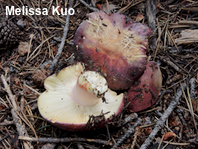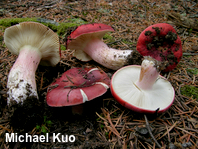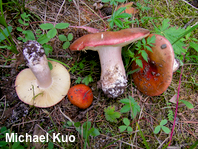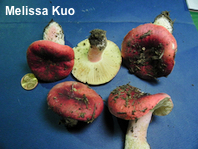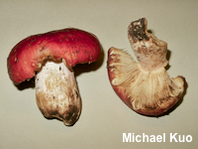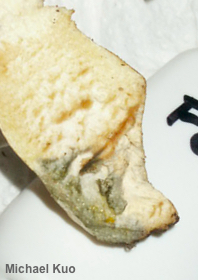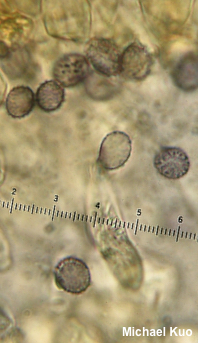| Major Groups > Gilled Mushrooms > Pale-Spored > Russula > Shrimp Russulas > Russula olympiana |

|
[ Basidiomycota > Russulales > Russulaceae > Russula . . . ] Russula olympiana by Michael Kuo, 1 October 2025 Russula olympiana appears to be western North America's most common shrimp russula. It is mycorrhizal with various conifers, and it features cap colors that are highly variable, but are most often in the purple-to-red portion of the spectrum. The stem is usually flushed with pink, red, or purple—and, like the stems of other shrimp russulas, it turns green with a drop of iron salts. Other features shared with all shrimp russulas include the brown-staining surfaces and, of course, the shrimp-like odor. Russula olympiana appears in many western North American field guides as "Russula xerampelina." Description: Ecology: Mycorrhizal with various conifers; growing alone or gregariously; summer and fall; originally described from Washington (Noffsinger & Buyck 2024), with collections also cited from British Columbia, Oregon, and Colorado; widely distributed from the Rocky Mountains westward. The illustrated and described collections are from Colorado. Cap: 4–8 cm; convex, becoming broadly convex, sometimes with a shallow central depression; bald; sticky when fresh; the cuticle peeling easily up to about halfway from the margin to the center; purple to purplish red or bright red; the margin not lined. Gills: Broadly attached to the stem; close or nearly distant; short-gills infrequent or absent; whitish, becoming dull yellow; spotting and bruising brownish. Stem: 4–8 cm long; 1.5–2.5 cm thick; equal; dry; bald; whitish, flushed with the cap color—or purplish to pink overall; bruising slowly brownish to yellow-brown. Flesh: White; staining slowly yellow-brown when bruised. Odor and Taste: Odor fishy; taste not distinctive, or slowly slightly acrid. Chemical Reactions: Iron salts on stem surface green. Spore Print: Dull yellow. Microscopic Features: Spores 9–10 x 6–8 µm including ornamentation; ellipsoid; ornamentation as amyloid, mostly isolated warts about 0.5 µm high, with few connectors; not reticulate. Basidia 42–50 x 11–14 µm; clavate; 4-sterigmate. Pleurocystidia 40–70 x 5–10 µm; fusiform or subcylindric, occasionally with an apical knob; smooth; thin-walled; contents granular; hyaline in KOH. Pileipellis an ixocutis; elements 2–4 µm wide, smooth, hyaline in KOH; terminal cells cylindric with subacute or merely rounded apices, occasionally long and tapering; subterminal cells occasionally swollen to 8 wide; pileocystidia not found. REFERENCES: C. R. Noffsinger & B. Buyck, 2024. (Arora, 1986; Schalkwijk-Barendsen, 1991; Roberts, 2008; Trudell & Ammirati, 2009; Desjardin, Wood & Stevens, 2015; Evenson, 2015; Cripps, Evenson & Kuo, 2016; Siegel & Schwarz, 2016; Bazzicalupo et al., 2017; Noffsinger et al., 2024.) Herb DBG RMNP 2009-035 (DBG 027464), RMNP 2012 5022-31. Herb. Kuo 08160304. This site contains no information about the edibility or toxicity of mushrooms. |
© MushroomExpert.Com |
|
Cite this page as: Kuo, M. (2025, October). Russula olympiana. Retrieved from the MushroomExpert.Com Web site: http://www.mushroomexpert.com/russula_olympiana.html |
